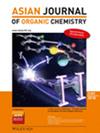解锁以碲为中心的自由基:从全有机合成的中间体到稳定的有机碲化物和催化剂
IF 2.7
4区 化学
Q1 CHEMISTRY, ORGANIC
引用次数: 0
摘要
从这个角度来看,有机碲化合物将在三个关键领域进行研究:含碲有机底物的合成(第2节),它们作为碳中心自由基前体的使用(第3节),以及它们作为有机催化剂的作用(第4节)。所有这些区域都包含作为中间体的碲自由基。碲的一个值得注意的特性是其所谓的硫键(ChB)能力,这是一种非共价相互作用,其中硫原子作为路易斯酸位点,通过它们的孤对或π电子与能够作为路易斯碱的原子或基团相互作用,类似于卤素键。碲的这一显著特性优于其较轻的硫和硒的对应物,并推动了碲化合物在有机转化和其他许多反应中作为催化剂的使用。本文章由计算机程序翻译,如有差异,请以英文原文为准。

Unlocking Tellurium‐Centered Radicals: From Intermediates in Total Organic Syntheses to Stable Organotellurides and Catalysts
In this perspective, organotellurium compounds will be examined across three key areas: the synthesis of organic substrates bearing tellurium (Section 2), their use as carbon‐centered radical precursors (Section 3), and their role as organocatalysts (Section 4). All these areas will include the tellurium radical as an intermediate. A noteworthy property of tellurium is its so‐called chalcogen bonding (ChB) capacity, a non‐covalent interaction in which chalcogen atoms function as Lewis acid sites, interacting with atoms or groups capable of acting as Lewis bases through their lone pairs or π electrons, in a manner akin to halogen bonding. This salient property of tellurium outperforms that of its lighter sulfur and selenium counterparts and drives the use of tellurium compounds as catalysts in organic transformations and other numerous reactions.
求助全文
通过发布文献求助,成功后即可免费获取论文全文。
去求助
来源期刊

Asian Journal of Organic Chemistry
CHEMISTRY, ORGANIC-
CiteScore
4.70
自引率
3.70%
发文量
372
期刊介绍:
Organic chemistry is the fundamental science that stands at the heart of chemistry, biology, and materials science. Research in these areas is vigorous and truly international, with three major regions making almost equal contributions: America, Europe and Asia. Asia now has its own top international organic chemistry journal—the Asian Journal of Organic Chemistry (AsianJOC)
The AsianJOC is designed to be a top-ranked international research journal and publishes primary research as well as critical secondary information from authors across the world. The journal covers organic chemistry in its entirety. Authors and readers come from academia, the chemical industry, and government laboratories.
 求助内容:
求助内容: 应助结果提醒方式:
应助结果提醒方式:


